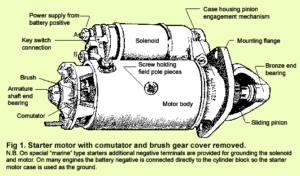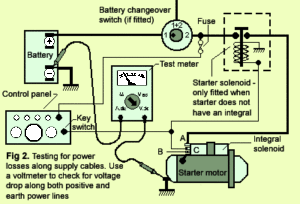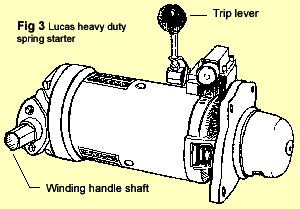
In an earlier article we looked at engine alternators; the types of things that go wrong and the types of repairs that can be realistically carried out on board. This month we take a look at engine starters and how to avoid the sickening feeling that comes when you most need your engine but when the key turns, you get nothing at all or just clunks and rattles from the starter motor. Unlike petrol engines, diesel engines, once they are going, will run quite comfortably without a battery or, for that matter, without any kind of electrical paraphernalia at all. Unfortunately, to get them going in the first place demands a considerable amount of energy and, since most boats use electric starters, the battery and alternator are in fact vital parts of the system. On the whole, starter motors themselves don’t often give trouble; far more common are faults that seem to be starter motor problems but are really rooted in other parts of the electrical fabric. So, before we start unbolting the starter and stripping it down, let’s begin by checking its supply of power.
DELIVERING THE POWER
When compared with most other pieces of boat electrics, starter motors demand a truly enormous amount of current. Several hundred amperes are needed, which is about the output of a biggish welding set or the power of a small outboard. In handling such currents, very large diameter cables (typically 35 or 50 mmý) and heavy duty connectors are called for. This is because even a small resistance in the circuit will cause a heavy loss of power. For example, if the starter draws 200 amps, a loose or dirty connector with a resistance of only one hundredth of an ohm will dissipate 400 watts. The practical effect is that it quickly overheats, expansion further loosens the joint and maybe the adjacent insulation begins to burn.
Dirty or loose electrical connections are by far the most common cause of starter motor problems. If they become warm then obviously they need attention but appearances are often deceptive. Multitest meters are not very good at measuring low cable or connector resistances but Fig 2 shows a way of using the volts scale to check them under load. This is really a two handed job and needs someone to run the starter for a few seconds (with the engine stop in the off position) whilst you check voltage drop along the supply lines. Remember that if the starter is drawing 200 amps, every volt dropped along the supply lines represents 200 watts of lost power.
STARTER CONTROLS
Starter key switches have light duty contacts, quite incapable of handling the large currents directly. Their function is to pass a small current which is used to turn on a larger, electrically operated switch or solenoid relay. In cars and some small marine engines, the solenoid is often mounted separately from the starter (see fig 2) . On most marine diesels, the solenoid is mounted above the motor body. Here, in addition to switching current, it also operates a mechanism for engaging the pinion in the engine ring gear (ie. bendix mechanism).

Current passing through the key switch is normally drawn from a fuse on the engine control panel. On some, it is also passed through an additional switch on the gear lever, intended to prevent the engine from being started when forward or reverse are engaged. Added complexities in these circuits can be annoying as the probable effect of loose wiring or a simple fault is that the key switch will not operate the starter. However, the good news is that the circuit is easily bypassed and, at a pinch, a temporary connection can be used to get the engine going. Bypassing the key switch wiring is simple enough, though there are risks that you should be aware of. Firstly, some sparks are likely so take care to use good ventilation, remove all solvents and flammable materials. Secondly, with such a large amount of available current, making a wrong, short circuit connection can cause cables to become extremely hot, burning their insulation and maybe causing further shorts. Thinner wires seem to explode in a burst of molten metal and sparks. The risk of fire and burns is obvious.

To bypass the key switch, first identify the solenoid connections marked A, B & C in fig 2. Then simply make a temporary connection, a short length of 1.5 mm² cable will do, between the incoming power supply (A) and key switch connection (C). As the two are joined together there may be small sparks but the solenoid should close and the starter run as normal.
STARTING WITH A LOW BATTERY
Flat batteries are surely the most common cause of engine starting difficulties. If it’s not totally flat, the solenoid may click and chatter or the engine turns over with little enthusiasm. If the battery is a few years old and cannot hold charge for long, a replacement is the only long term solution but if it has been flattened by leaving the odd light or pump on for too long, it should be recharged as soon as possible. Of course, the catch 22 is that without an alternative power source, we need the engine going to recharge it. So is there anything that can be done that will at least maximise our chances of getting the engine going with what little charge is left?
Well, sadly not too much, though there are a couple of possibilities to bear in mind. If, after using the starter for a longish period of engine cranking, the battery seems flat and no longer turns the engine with the same enthusiasm, do not persist with trying to get the engine to go but wait for a while. When called to deliver a heavy current, batteries attempt to reduce their output by dropping their terminal voltage. The effect is greater in older batteries, but after delay of 15 or 30 minutes the voltage largely recovers, making it possible to draw more current. As might be expected, there is a limit to the number of times you can try this, but at least the delay gives time to take stock of the situation and correct any other faults that may be preventing the engine from starting.
CHEMICAL SOLUTIONS
Spray cans of fluids sold to help start stubborn engines can be useful in very cold conditions or if you have little battery power. A quick squirt in through the air intake can make all the difference. Some people report that their engines become addicted to these fluids and won’t start without them. I can see no reason why this should be so, though if an engine is in bad condition, prolonged use is likely to make it worse and more difficult to start, regardless of whether an easy starting fluid is used. Diethyl ether is the main ingredient of these products. This is an extraordinarily flammable liquid (more so than petrol), and should be stored and used with the same care as you would take with bottled cooking gas. Personally, I prefer not to use easy starting fluids and take the attitude that if an engine is normally difficult to start, there is some other problem that should be dealt with. However, I do carry a little diethyl ether just in case the need arises. *** See Note.
STARTING WITHOUT ELECTRICITY
Once upon a time, when cold winter mornings and flat batteries made the car difficult to start, you could still get to work on time by using the starting handle. These days, no self respecting car manufacturer would dream of fitting such an antique device to their latest creation and the idea was also abandoned on most, but not quite all, small marine diesels. See Photo 1
To make the engine easier to turn over, each cylinder head is fitted with a small lever that held open a decompression valve. With all cylinders decompressed, the engine is turned over quickly by hand and when its heavy flywheel is spinning as quickly as your stamina will allow, you quickly shut one or more of the decompression levers. With luck, the flywheel will have gained enough momentum to carry the engine over compression and so it starts. Even on a stable platform the job is not always easy and in a seaway, in the confines of a small boat, it can be a truly formidable task, which is why most of these engines also have electric starters. None the less, the capability for hand starting is a most desirable feature and I have known one or two owners who have gone to extraordinary lengths to modify their engines to take decompressors and starting handles.
CLOCKWORK STARTERS
It may sound like a joke but clockwork starters are really an excellent idea. The principle of winding up a spring, then using the stored energy to turn over the engine is well tried and tested and the Lucas spring starter in fig 3 proves the point. This particular type can start even quite large engines – up to 7.5 litres with up to 1.25 litres per cylinder. A good feature of these is that their three bolt, flange fitting mount is exactly the same as those used on many electric starters so they can provide a quick, direct replacement. Even if you would rather stick to the convenience of electric starting, one of these units could some day earn its keep as a spare, covering failure of the electrical system as well as well as failure of the original. Unfortunately, clockwork starters have never been really popular, maybe due to their high price, though occasionally they turn up in boat jumble sales.

On many modern diesels, totally non-electric starting would be very difficult to achieve. These are engines in which it is essential to preheat the combustion space before using the starter. Though this may take only seconds, a few hundred watts of power are required and it’s hard to think of a safe alternative to electricity. Of course, not all engines work in this way and direct injection diesels will often start from cold with relative ease. However, when one considers the difficulties of hand starting, especially under unfavourable conditions, the need to preserve the integrity and sheer convenience of the electrical system is clear. A separate engine battery with its own dedicated alternator, and a regular program of inspection and maintenance are about the best insurance.
——000—–
*** NOTE
If all else fails …
Here’s an idea that was passed to me by an ex charter skipper and though the idea has worked in practice, I am hesitant to pass it on. This is because getting it wrong carries a serious risk of causing extensive and expensive engine damage. It’s a desperate method and one for desperate circumstances, but here goes. The principle is to decompress the engine by placing metal shims between each exhaust valve tappet. Strings are tied to each shim and the starter is used to turn over the engine with what battery power is left. Since the engine is decompressed it takes relatively little power to turn it over quite quickly and enable the flywheel to gather momentum. Once spinning, the strings are tugged to withdraw the shims and if luck holds, the engine starts. Now, the danger in this technique is that it reduces the already very small distance that normally exists between exhaust valves and pistons when at the top of their stroke. If at any time a piston actually touches a valve, considerable damage will be caused, needing major repairs to put right.
STARTER MAINTENANCE
Starters are normally one of the more reliable engine accessories, needing very little preventative maintenance. There are though, a few areas that occasionally give trouble and can benefit from a little attention on roughly an annual basis. As a safety precaution, before removing a starter for repairs, first disconnect the positive lead from the battery. Otherwise, when the other end of the same cable is disconnected from the solenoid, there is the risk of its loose end accidentally touching other engine parts. The resultant short circuit will make lots of sparks, flatten the battery and could cause a fire.
Brushes and commutator
After removing the end cover, relieve the tension on one of the brush springs either by removing it or using a matchstick to hold it away from the brush. Next, gently pull the brush by its connecting lead to make sure it can move freely in its holder. Any tendency to stick needs to be treated by using a cleaning fluid to remove any deposits on the brush or the inside of its holder.
Brushes that have worn down to less than 50% of their original length should be renewed. When allowed to wear much beyond this, there is increased risk of damage to the commutator. Normally, the copper comutator will appear just slightly tarnished but any heavier, hardened deposits need cleaning away with fine emery paper. If worn brushes have cut deep grooves in its surface, the commutator can still be recovered by skimming in a lathe, though for most people this will be a job for an onshore machinist.
Mechanical parts
Make sure that the pinion and its engagement mechanism are operating freely. After cleaning away any corrosion, dirt or metal particles and replacing any worn parts, apply a little light grease to keep it in good condition. Also, apply a few drops of oil to the armature shaft bearings. Finally, before reinstalling the starter, make sure that the bolts holding the field pole pieces and case together are tight.
TROUBLE SHOOTERS GUIDE
| SYMPTOM | possible cause |
| You turn the key and absolutely nothing happens | Low battery]or open circuit key switch wiring (check that the solenoid connection is at +12 volts when starter switch is turned on)
or burnt out solenoid contacts or loose or corroded connections to the battery, battery change over switch, ground, earth terminal, solenoid or starter.. or starter very loose in its mount causing a poor connection to the ground or earth. |
| You turn the key and get only a few rattles and clicks from the starter or solenoid | Low battery
or loose or corroded battery, or loose or corroded power supply leads, or ground connection. or starter very loose on its mount or dirty or loose brushes or commutator |
| Starter motor struggles but doesn’t quite turn the engine over with its usual verve | As above or water has entered the cylinders (maybe cooling water from the exhaust) and is causing a hydraulic lock
or internal short in the starter motor windings or field pole pieces within the starter have become loose and are rubbing against the armature or jammed or rusted drive mechanism |
| Starter motor works but is unusually noisy | Worn drive mechanism
or worn armature shaft bearings |
| Starter spins smartly but engine does not turn over | or bolts securing the starter or holding the case together or securing the field pole pieces are loose |
| Starter will not disengage | Key switch contacts are faulty and failing to open
or broken solenoid plunger spring Rusty or dirty helical drive shaft |